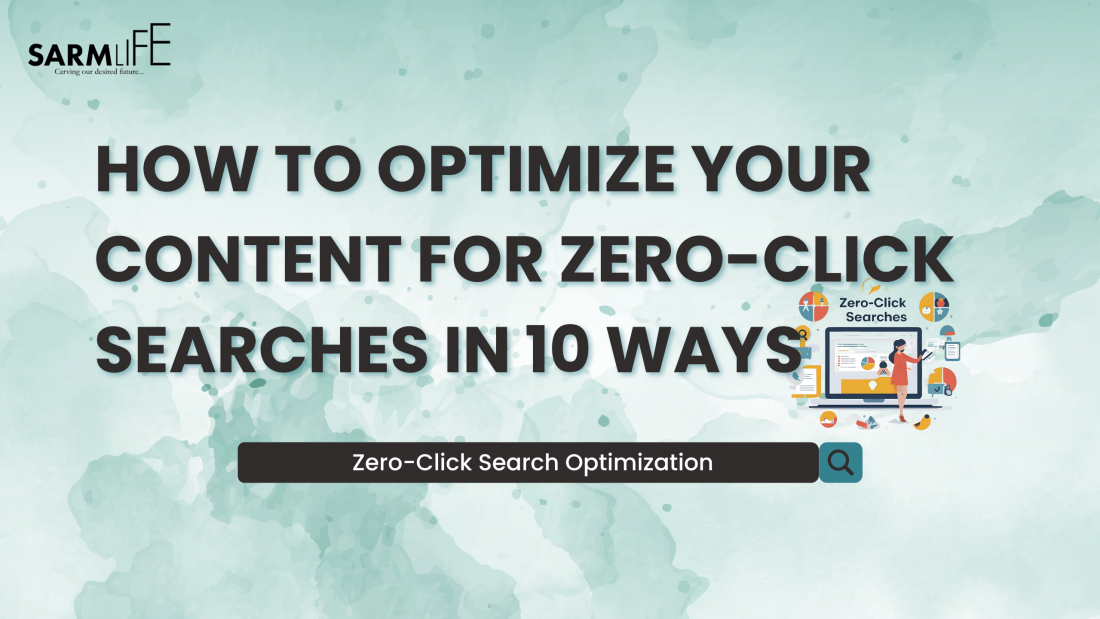Have you noticed that more people are searching and not clicking? You’re not imagining it. Welcome to the season of zero-click searches.
With these search results, users get their answers on the search engine results page without visiting a website. As a business owner, content creator, or marketer, this can feel frustrating. You’re doing the work, but Google gets the credit.
But here’s the good news: zero-click doesn’t mean zero opportunity. If you know how to optimize correctly, zero-click results can help you build authority, visibility, and brand recognition.
This article explores what zero-click searches are, why they matter, and how you can strategically position your content for them, starting today.
RELATED BLOG POSTS
- 5 REASONS WHY CONTENT MARKETING IS IMPORTANT FOR YOUR BUSINESS
- 5 IMPORTANCE OF BLOG MARKETING FOR BUSINESS GROWTH – SARMLife
- BENEFITS OF BLOGGING FOR BUSINESS IN 2025: WHY YOU SHOULD START NOW! – SARMLIFE
- 5 UNIQUE TIPS TO MAXIMIZE YOUR GUEST BLOGGING EFFORTS – SARMLIFE
What Are Zero-Click Searches?

Photo by SecureITWorld
Zero-click searches are search results that provide answers directly on the SERP, so users don’t need to click through to a website. Common examples include:
- Featured Snippets
- Knowledge Panels
- People Also Ask boxes
- Local Packs
- Direct Answers (like time, currency conversions, or definitions)
With the rise of Google AI Overview, Bing Copilot, and voice search, these types of results are on the increase. According to Search Engine Land, over 57% of Google searches result in no clicks.
In this environment, content marketing strategies need to evolve. It’s not just about ranking; it’s about owning the real estate users engage with the most. Appearing in a zero-click format also builds mental availability. Even if users don’t click, your name is imprinted. And that’s powerful for brand recall, especially for businesses in saturated markets.
Moreover, zero-click appearances often get voice search traction. When Google Assistant or Alexa answers a voice query, it usually pulls from featured snippets. As a result, your content can speak directly to users without a screen, and that kind of brand proximity is the future of ambient search.
Why Zero-Click Searches Matter for SEO

Photo by PageTraffic
The shift toward instant answers on search engines is changing how we measure SEO success. Click-through rate (CTR) is no longer the only metric that counts.
- Visibility beats visits: Even without clicks, being seen in a Featured Snippet boosts brand awareness.
- Authority signaling: Getting featured means Google trusts your content.
- Top-of-funnel exposure: You’re the first touchpoint in a customer’s journey.
While clicks may decrease, the value of SERP real estate has never been higher.
10 Strategies to Optimize for Zero-Click Searches

Photo by Semrush
Here are some strategies to optimize for zero-click searches:
1. Target featured snippets.
Use concise paragraphs, tables, lists, and definitions to answer specific questions. Keep the answer within 40–60 words if possible.
Example: If someone searches “What is zero-click search?” and your content provides a brief, direct definition, you have a higher chance of being selected for a snippet.
2. Provide concise answers.
Use direct, jargon-free language. Place the most essential answer within the first 100 words of your section or article.
Example: When writing a how-to blog post, starting with a concise summary helps you grab the reader’s attention. This summary should provide a concise overview of the post’s content and what readers can expect to learn.
3. Use headers and bullet points.
Organize content with H2s, H3s, and bullet points. Search engines love scannable content.
Additionally, you can turn subheadings into questions that users are searching for using long-tailed or conversational keywords.
4. Implement schema markup.
Structured data helps Google understand your content. Implement:
- FAQ schema
- HowTo schema
- Article and BlogPosting schema
Example: A recipe page with HowTo schema is more likely to show up in voice search and smart assistant results.
5. Include FAQ sections in your content.
Google pulls questions and answers from your page into PAA (People Also Ask) boxes—format FAQs with clear, straightforward answers.
Example: Use headings like “What is…” or “How do I…” to match natural search phrasing.
6. Optimize Google Business Profile.
Ensure your profile is complete, with your current contact info, services, images, and reviews. This method boosts your presence in the Local Pack, a typical zero-click result for local searches.
Example: A restaurant’s GBP with updated hours, photos, and FAQs can dominate zero-click results for local food queries.
7. Use visual and video content.
Video snippets and image packs are powerful zero-click formats. Add schema to video content, create transcriptions, and optimize file names and alt text for all images.
Example: A “how to tie a tie” video with structured data can land in the top carousel without a single click-through.
8. Build and claim knowledge panels.
Establish credibility with:
- Wikidata entries
- Schema for your brand and people
- Consistent brand mentions on authority sites
This system increases the likelihood that Google will build a knowledge panel around your entity.
Example: Authors and businesses can appear with knowledge panels by getting listed in online databases and publishing consistent, branded content.
9. Own your branded SERP.
Optimize for your name or business. Ensure meta descriptions, About pages, and social profiles are updated and appear prominently on the first page.
Example: A consultant’s Google result shows their LinkedIn, portfolio, and client reviews.
10. Partner with SARMLife for strategic content.
Zero-click searches can feel discouraging: your content is ranking, but users aren’t clicking through.
However, the brands that win in this new landscape are those that focus less on traffic and more on visibility, authority, and relevance. That’s where SARMLife comes in.
What Sets SARMLife Apart?
- Search-intent-focused content: By understanding search intent, SARMLife crafts answers that directly respond to the questions your audience is asking.
- Structured for search engines: Clear headings, bullet points, schema markup, and strategic keyword placement make it easier for Google to surface your information in zero-click formats.
- Schema implementation and technical SEO: From FAQ and HowTo schemas to entity recognition, their strategies increase the possibility of being featured in rich results.
- Brand authority embedded in content: SARMLife builds authority by weaving consistent branding, tone, and citations into every article, so even when your content is paraphrased or summarized, your brand remains recognizable.
Risk of Zero-Click Searches

Photo by Freepik
While there are benefits, let’s not sugarcoat the challenges:
- Loss of traffic: If your answer is used, users may never visit your site.
- Attribution issues: Google doesn’t always credit the source.
- Lower engagement: Visitors who don’t land on your site won’t engage with your calls to action.
- Lack of data ownership: With traditional SEO, site visits provide metrics such as bounce rates, conversions, and time on site. Zero-click results rob you of those insights.
However, rather than seeing these challenges as a threat, it’s better to view them as a branding opportunity.
The aim is not to resist change but to embed your brand identity so deeply in your content that even when paraphrased or summarized, the essence of your voice remains recognizable.
This reason makes it crucial to combine zero-click strategies with other forms of SEO and brand nurturing.
Turning Zero-Click Exposure into Brand Authority

Photo by LinkedIn
Here’s how to turn impressions into influence:
- Utilize multi-touchpoint SEO: Zero-click searches can increase your visibility. Retarget visitors through ads, email sequences, or social platforms.
- Brand your snippets: Include your brand name subtly in your content (e.g., “According to [Brand Name]…”).
- Focus on long-term authority: Consistently being featured builds search engine trust.
Think of zero-click presence as a brand positioning tool. It helps shape the first impression users get about your niche authority.
Even if users don’t convert immediately, repeated zero-click appearances increase trust. Over time, users may actively seek out your brand, thereby bypassing the need for search altogether.
One underrated trick is to treat each blog post like a mini landing page. Even if it doesn’t convert directly through a click, it can act as a conversion seed.
When you eventually run retargeting campaigns on social media or YouTube, the familiarity you built through zero-click exposure accelerates the trust curve.
Final Thoughts: Visibility Is the New Click

Photo by Embryo
Zero-click searches aren’t a dead end; they’re a new beginning. By optimizing your content to appear in featured results and SERP elements, you’re positioning your brand as a top authority.
Traffic will always be significant. However, by 2025, visibility, trust, and discoverability will be the new currency of SEO success.
As zero-click searches evolve, so must your metrics. Tools like Google Search Console, BrandMentions, and Semrush’s featured snippet reports are now critical parts of a modern SEO stack.
Remember, SEO isn’t dying. It’s adapting. The focus has shifted from “ranking to be seen” to “structuring to be understood.” The brands that understand this will dominate SERPs in 2025 and beyond, not just in terms of clicks but also in terms of influence.
FAQs On Zero-Click Search
What is a zero-click search?
This is a search that ends on the SERP without the user clicking on any results. Standard formats include Featured Snippets, People Also Ask, and Knowledge Panels.
How do I optimize for zero-click results?
Write concise answers, use structured formatting, implement schema markup, and target FAQs and long-tail keywords.
Does zero-click search reduce traffic?
It can, but it also boosts brand visibility and authority. Many businesses find increased indirect traffic and recognition from these features.
Can I measure success in zero-click SEO?
Yes. Use tools like Google Search Console to track impressions and visibility and monitor your presence in featured SERP elements.
Is zero-click SEO relevant for small businesses?
Absolutely. Local Packs, Google Business Profiles, and FAQs are especially valuable for small brands trying to own their niche.
What tools can help identify zero-click opportunities?
Use tools like Semrush, Ahrefs, AlsoAsked, and AnswerthePublic to find featured snippet opportunities and PAA data.
Are you ready to optimize for future searches? Start by applying just three of the strategies above, and watch your visibility grow—click or no click. Send us a DM or email us: hello@sarmlife.com to aid you with these applications.
READ MORE: SEO WRITING | 11 PROVEN TIPS ON WRITING BLOG POSTS THAT RANK ON GOOGLE


Add a Comment